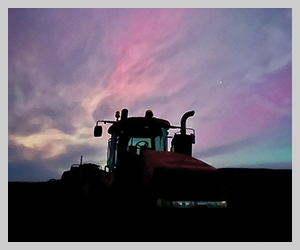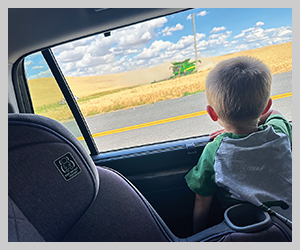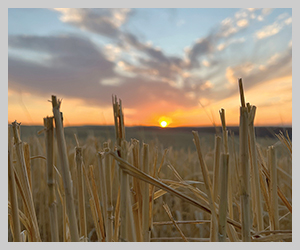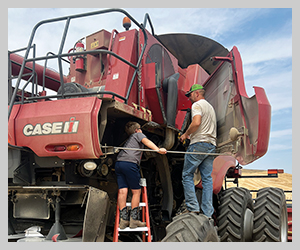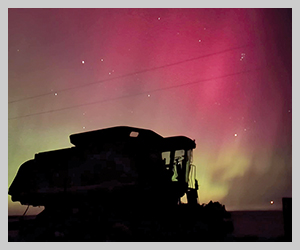Wheat and Greet 2021 event brings stakeholders together to celebrate small grains industry
2022January 2022
By Trista Crossley
Editor
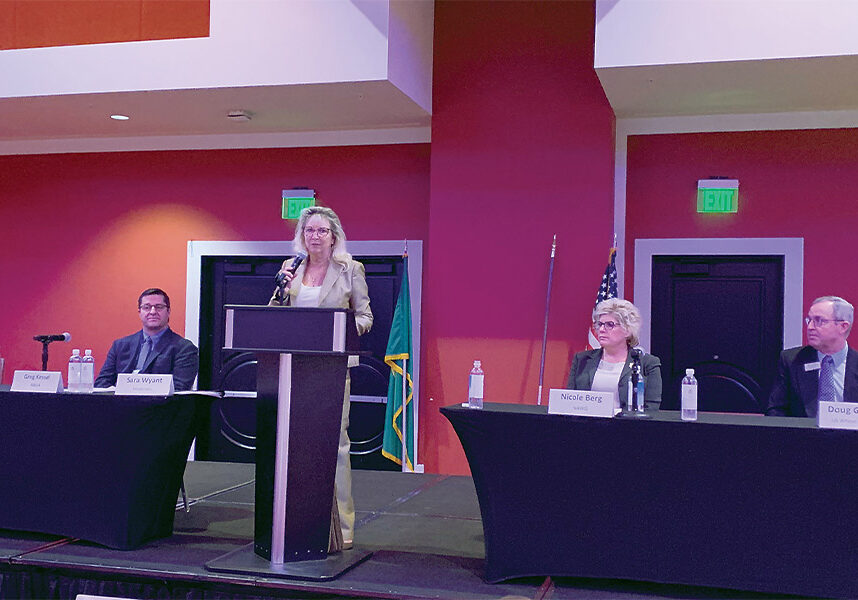
After having to cancel last year due to COVID-19, this year’s Tri-State Grain Growers Convention had a lot of ground to cover. Producers gathered at the Davenport Grand Hotel in Spokane, Wash., Nov. 30 to Dec. 3, to listen to noted national speakers discuss the way consumers view food production; the importance of mental, not just physical, health; smart marketing in the face of high input costs; and long-term weather projections. U.S. Department of Agriculture Secretary Tom Vilsack addressed producers in a video, and the major industry organizations took part in a national issues panel hosted by Sara Wyant, a veteran farm policy reporter.
Educational break-out sessions ran the gamut, from crop insurance updates (see page 17) to estate planning, river transportation, carbon markets, variety research, management plans and the upcoming 2023 Farm Bill (see page 18).
Like Oregon and Idaho, the Washington Association of Wheat Growers (WAWG) held an annual meeting followed by an awards banquet (see page 8). Drawings were held throughout the convention. Dolly Blankenship of Ritzville, Wash., won a free night’s stay at the Coeur d’Alene Resort for the 2022 convention in the early bird drawing. Marlene Poe of Hartline, Wash., and Lindsay Murdock of Oregon both won a free registration to the 2022 convention as co-winners of the photo contest. As the overall survey winner, Sara Carlson of Oregon also won a free registration to the 2022 convention, as well as a gift package from Dry Fly Distillery. In the exhibitor blackout game, Rich Remington of Oregon won a gift basket from AgPro Marketing and Manufacturing.
The wheat organizations of Idaho, Oregon and Washington want to thank everybody who made the convention possible, especially our sponsors, industry supporters and exhibitors (see list on page 10). Please join us next year in Coeur d’Alene, Idaho, Nov. 29-Dec. 2 for the 2022 convention.
National issues update
Kicking off convention proper was an overview of national issues, including a panel of national organization representatives. Sara Wyant, a veteran farm policy reporter and president of Agri-Pulse Communications, moderated the panel. Agri-Pulse covers the latest on national farm policy, commodity and conservation programs, trade, and environmental and regulatory issues.
Wyant started the conversation by summarizing some of the ag impacts of Pres. Biden’s Build Back Better legislation, which has passed the House and, as of early December, was being debated by the Senate:
- $27 billion in new conservation funding.
- A $5 billion program that would pay farmers $25 per acre for five years to plant up to 1,000 acres of cover crops.
- $9 billion earmarked for the Environmental Quality Incentives Program.
- $7.5 billion for the Regional Conservation Partnership Program.
- $4.1 billion for the Conservation Stewardship Program.
- $600 million for a new U.S. Department of Agriculture program to measure the impact of conservation practices on greenhouse gas emissions and carbon sequestration.
- $2 billion for agricultural research.
Importantly, if the legislation is passed by the Senate, Wyant said it could build on the farm bill’s baseline, increasing the available funding for the 2023 Farm Bill.
Like farmers, Wyant is closely watching the federal government’s actions concerning cover crops and a proposed program that would pay farmers $25 per acre to plant them.
“We feel it is important to understand what could happen with an incentive like this. What are the unintended consequences that might result from this kind of incentive?” she asked. “Obviously, if everybody could plant cover crops right now and it worked, that would be one thing. But it doesn’t work in arid parts of the county. And if you harvest your cover crop…than it’s not considered a cover crop because you are getting a revenue from it. There’s a lot of different issues that we need to explore.”
Agri-Pulse recently conducted a poll of farmers. The top issue was protecting the country against acts of terrorism, followed by the need to increase overseas sales of ag products and stopping illegal immigration. Farmers also reported the need for more education and understanding on reducing ag’s carbon footprint. According to the poll, more than a quarter (29 percent) of farmers are actively implementing practices that reduce their carbon footprint with 32 percent wanting to better understand the issue. Nearly a quarter, 22 percent, said they didn’t think there was a need to address greenhouse gas emissions. When it comes to cover crops, farmers said soil integrity was the key benefit to cover crops, but cost is the main barrier preventing them from investing in the practice. Sixty-one percent of farmers said they’d need at least $40 an acre to make planting cover crops worthwhile.
Switching over to a more regional issue, Wyant said there’s a need to educate the “other” Washington about what’s at risk if the Columbia-Snake River System isn’t preserved. She said this administration is one of the most tribal-friendly administrations she’s seen with a lot of recognition of tribal concerns. Setting aside the nation’s history with Native Americans, she said there are ways to have win-wins with the salmon, with the tribes and with the farm community. She pointed to California rice farmers who have collaborated with environmental groups to set up practices that help both the salmon and the farmers.
“We are sometimes kind of shy about telling our story and engaging folks who are on the total opposite side of our position. There ought to be some things you can do if you think outside the box. Put your marketing hats on and try to overcome this really negative narrative that some of the tribal spokespersons have used,” she said. “It’s almost like you are trying to kill their culture and everything. I’ve got to think that there are a lot of those who could sit down, break bread, drink beer, eat salmon and find a win-win in this, but it’s going to take more money, more time.”
Wyant then invited the four panelists to introduce themselves and give a short update.
Nicole Berg represented the National Association of Wheat Growers (NAWG). Over the past year, NAWG has been working to make sure that wheat growers were fairly represented when Congress doled out federal ad hoc disaster funding, especially through the WHIP+ program, and addressing quality losses caused by natural disasters. She said Oregon has received approximately $52 million, Idaho $102 million and Washington $174 million.
Berg said Washington, D.C., is very hard to get into with many federal offices still closed, which has made advocating for the wheat industry harder.
“Over the last year, we have been zooming all of the time,” she said. “Zoom has become the modus operandi. But we have new legislative aides coming in, new people coming in, so we’ve got to get up there and educate folks.”
Berg said the next farm bill is rapidly approaching. She expects NAWG to start deciding what the industry will and will not support and encouraged producers to figure out how to make the next farm bill better fit the wheat industry. NAWG also has a new grassroots campaign email tool that helps wheat farmers more easily express their concerns to members of Congress.
“Policy is not driven by one person. No one person can drive policy, but with all your help, we sure can,” she said.
Doug Goyings, past chairman of U.S. Wheat Associates (USW), said COVID-19 has dramatically changed how USW operates. Like NAWG, USW has also been participating in lots of Zoom meetings, which has had an unexpected benefit of allowing U.S. farmers to talk to more people without having to travel.
“It has helped us reach more of our buyers and millers to educate them more on U.S. wheat,” he said.
Representing the National Barley Growers Association (NBGA) was Washington Grain Commissioner Kevin Klein, a NBGA board member from Edwall, Wash. Klein said 2021 barley production nationwide was down by 31 percent from 2020. The lower supplies are resulting in increased cash prices for feed barley, malt barley and pet food barley. In the Pacific Northwest, 2021 barley production was down 21 percent in Idaho, 72 percent in Oregon and 58 percent in Washington.
“For the past year, China has had a little tiff with Australia, and the imports from Australia have been going down. That’s where Canada has been stepping in, and a lot of our barley from Washington has been going to Canada to cover that,” he said.
Casey Chumrau, executive director of the Idaho Wheat Commission, represented the Wheat Foods Council (WFC). The WFC is made up of 11 state wheat commissions plus millers, bakers, ingredient suppliers and others concerned and interested in promoting the quality and consumption of wheat. In the last few years, the WFC has been focusing on educating what Chumrau called “the multipliers.” The organization has been reaching out to influencers in different industries, especially fitness trainers, chefs and registered dieticians, to educate them on the nutritional benefits of wheat, the idea being that those influencers will share that information across their networks and clients.
“There’s still a lot of misinformation surrounding gluten, in particular,” Chumrau said.
The WFC has successfully switched from live events to videos and webinars, and the organization publishes two magazines: Kernels, which targets nutritionists and the general wheat foods industry, and FoodFit, which targets personal trainers.
‘Inputs are producers’ biggest risk’
Matt Roberts, a former commodity broker and professor, tackled one of farmers’ favorite subjects—marketing. The good news, he said, is prices for the major commodities—corn, beans, wheat—are solid. The bad news is labor markets and inflation rates. Most grains, he said, have been tightening for about six years, but there isn’t a fundamental shortage of grains. The exception is U.S. wheat.
“We’ve seen a massive drawdown in production over the past four years. We got to a point four years ago where we had nearly two-thirds of the entire year’s (wheat) consumption in storage at the start of harvest,” he explained. “We have started to see those inventories taken down, but it’s largely a reduction in production, not an increase in usage.”
Roberts made the point that nobody knows where the markets are going, so trying to predict them is useless.
“What you instead have to do is build your marketing plans from a basis of ignorance,” he said. “You don’t know where prices are going. The question becomes, what do you do with that knowledge? Marketing plans need to start from a place of what your balance sheet looks like because that tells you what risks you can afford to take. That’s where the rest of your marketing plans start.”
Inputs right now are most producers’ biggest risk. While wheat prices across the board are high, so are inputs. That’s where Roberts recommends producers start assessing risks.
“You’ve got to match your margins,” he said. “As you’re either pricing inputs or outputs, you have to be locking the other leg. If you are buying inputs, sell stock. You don’t have to sell a lot, but if you are going to make large crop sells for 2022/23, you have to be working somehow to control your input price risk. Other than prepurchase, there aren’t really good ways to do that. That is a big constraint but it’s a source of huge risk. It becomes a margin game. Is your margin there?”
Fortunately, Roberts said even though input costs are at record levels, current prices are good enough to keep most producers solidly profitable. He said that’s not an excuse to sell everything, but it is an excuse to start selling.
Roberts also touched on a couple of other points, including:
- Inflation. The massive growth in debt, deficit and money supply has been going on since the mid-1980s. He said the reason many people have been pretty relaxed about increasing inflation over the past year is because this isn’t a new thing; we just haven’t seen much evidence of it because of how inflation is calculated and tracked (inflation doesn’t include the stock market and certain assets, such as land and house prices).
- Energy prices. Roberts said the energy crisis has nothing to do with the current administration or canceling pipelines. It’s a supply chain-type disruption in energy. It’s a rapid growth in demand post-COVID. It’s reduced U.S. oil output. “Any time we have a big change in the markets, it’s never one thing. It’s a factor of things that all contribute. We need a faster return to fracking. That’s how we break OPEC, and that’s how we will ultimately bring prices down,” he said.
- Supply chain. Like energy prices, Roberts said there are multiple contributing factors causing problems. He described commerce as a “finely tuned machine” where everything is lined up, able to deliver products where they were needed, when they were needed. Even during COVID, at the consumer level, people didn’t go hungry for a lack of food. “The system didn’t fundamentally collapse, but we did see the stresses on it,” he explained. “The system just doesn’t have much slack, because slack—or resilience—is expensive.”
- Labor shortages. Shortages in the labor market existed before COVID, and Roberts believes they aren’t going away. Some of the reasons for the labor shortage include an increasing amount of baby boomers retiring and fewer immigrants coming to the country in the last few years. He expects to see wages adjust to the demand and more mechanization will fill holes.








